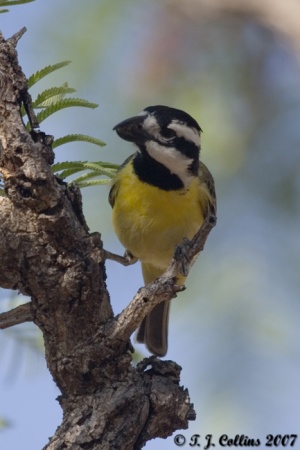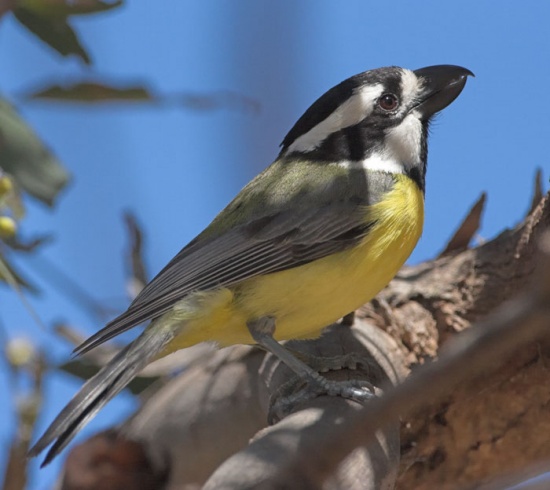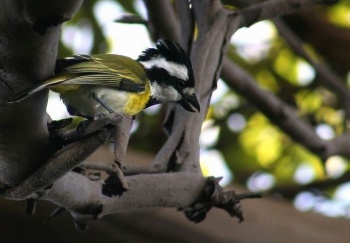(Reference updated) |
(Typo.) |
||
| Line 8: | Line 8: | ||
''Whitei'' is smaller and paler.<br /> | ''Whitei'' is smaller and paler.<br /> | ||
Females are similar to males but have a dark olive-green throat. | Females are similar to males but have a dark olive-green throat. | ||
| − | [[Image:Northern_(crested)_shrike-tit.jpg|thumb|300px|right|Northern Shrike-tit (''whitei'')<br />Photo by {{user|tcollins|tcollins}}<br />Katherine Region, [[Northern Territory | + | [[Image:Northern_(crested)_shrike-tit.jpg|thumb|300px|right|Northern Shrike-tit (''whitei'')<br />Photo by {{user|tcollins|tcollins}}<br />Katherine Region, [[Northern Territory]], [[Australia]], October 2007]] |
==Distribution== | ==Distribution== | ||
[[Australia]].<br /> | [[Australia]].<br /> | ||
| Line 19: | Line 19: | ||
* ''F. f. whitei'' (Northern Shrike-tit) from N [[Australia]] | * ''F. f. whitei'' (Northern Shrike-tit) from N [[Australia]] | ||
Some authorities (Howard & Moore) merit full species status to all three forms. However neither Clements nor Sibley & Monroe have accepted this split and the Opus awaits further clarification. | Some authorities (Howard & Moore) merit full species status to all three forms. However neither Clements nor Sibley & Monroe have accepted this split and the Opus awaits further clarification. | ||
| − | + | ||
==Habitat== | ==Habitat== | ||
Woodlands. | Woodlands. | ||
==Behaviour== | ==Behaviour== | ||
====Diet==== | ====Diet==== | ||
| + | [[Image:35409Crested shrike-tit 001.jpg|thumb|350px|right|Western Shrike-tit (''leucogaster'')<br />Photo by {{user|aladyforty|aladyforty}}<br />Torbay, [[Western Australia]], July 2006]] | ||
Feeds mainly on insects, takes also spiders, fruit seeds and arils. Forages in trees, taking prey from barks or foliage. | Feeds mainly on insects, takes also spiders, fruit seeds and arils. Forages in trees, taking prey from barks or foliage. | ||
====Breeding==== | ====Breeding==== | ||
Revision as of 10:56, 27 May 2015
Alternative name: Eastern Shrike-tit
- Falcunculus frontatus
Includes Northern Shrike-tit and Western Shrike-tit
Identification
Dull green back and wings, yellow belly and boldly marked black and white head, with a small black crest. Its bill is unusually deep, strong and hooked.
Leucogaster has a white belly.
Whitei is smaller and paler.
Females are similar to males but have a dark olive-green throat.

Photo by tcollins
Katherine Region, Northern Territory, Australia, October 2007
Distribution
Australia.
Leucogaster is currently in decline due to loss of habitat and is considered vulnerable. The nominate form is of least concern.
Taxonomy
Subspecies
Clements accepts three subspecies[1]:
- F. f. frontatus (Eastern Shrike-tit) from SE Australia
- F. f. leucogaster (Western Shrike-tit) from Southwest Western Australia
- F. f. whitei (Northern Shrike-tit) from N Australia
Some authorities (Howard & Moore) merit full species status to all three forms. However neither Clements nor Sibley & Monroe have accepted this split and the Opus awaits further clarification.
Habitat
Woodlands.
Behaviour
Diet
Feeds mainly on insects, takes also spiders, fruit seeds and arils. Forages in trees, taking prey from barks or foliage.
Breeding
Breeding season from August to January, usually double-brooded. The nest is a deep cup, made by the female with bark strips and dry grass. It's placed 6 - 15m high in a tree fork. Lays 2 - 3 eggs.
Nests parasitized by Pallid Cuckoo, Brush Cuckoo and Fan-tailed Cuckoo.
Resident with some local movements.
References
- Clements, JF. 2011. The Clements Checklist of Birds of the World. 6th ed., with updates to August 2011. Ithaca: Cornell Univ. Press. ISBN 978-0801445019. Spreadsheet available at http://www.birds.cornell.edu/clementschecklist/downloadable-clements-checklist
- Del Hoyo, J, A Elliott, and D Christie, eds. 2007. Handbook of the Birds of the World. Volume 12: Picathartes to Tits and Chickadees. Barcelona: Lynx Edicions. ISBN 978-8496553422
Recommended Citation
- BirdForum Opus contributors. (2024) Eastern Shrike-tit. In: BirdForum, the forum for wild birds and birding. Retrieved 18 April 2024 from https://www.birdforum.net/opus/Eastern_Shrike-tit





